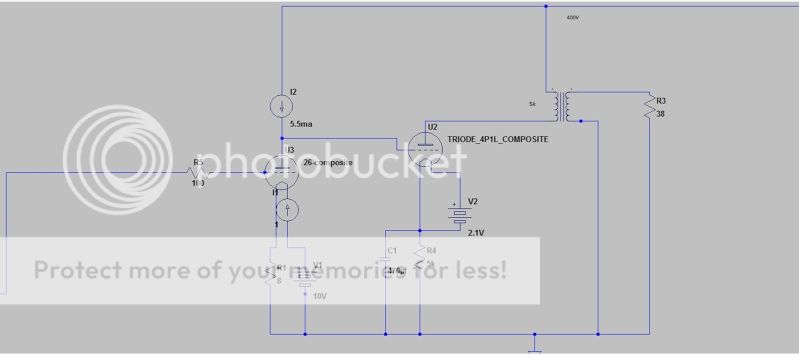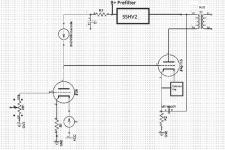Taking advantage of the low operating plate voltage of the 4P1l. I think with a #26 or #112 driver we could DC couple and save the expense of an IT/cap coupling. Then with a good supply like the SSHV which is good to 400V we could ultrapath a 4P1l output. Think it would give 2 watts?
Attachments
Last edited by a moderator:
You'll never get me playing around with anything over 400v and usually much less!
Big mistake!
Anyway it was just to tell that 300B isn't a convenient choice, in one way or another there always is a better solution....
Yes - I know you were knocking the plinth out from under the legendary 300b. A very overpriced tube, but at 'sensible' voltages it's still the leader in terms of watts per DHT. Go down a bit in watts and you have equally good or even better tubes.
Regal's Ultrapath and things like the DRD circuit are interesting in eliminating the coupling cap or transformer, but we have the ultrapath cap as a tradeoff. I never got this to sound that great, but I'm open to the idea that my circuit could have been improved.
Regal's Ultrapath and things like the DRD circuit are interesting in eliminating the coupling cap or transformer, but we have the ultrapath cap as a tradeoff. I never got this to sound that great, but I'm open to the idea that my circuit could have been improved.
Excluding audio transformers, except the OPT, one has to live with one cap at least in the audio circuit (decoupling or cathode or ultrapath) if DC coupling. Also the supply might not be simple and possibly the start-up has to be well thought. There are always trade-offs.....
Putting a decoupling cap at the input, o after the input stage if there are three stages, the driver could be supplied with a negative voltage so that the + termination of the CCS is grounded and it takes just the bias voltage (or a dual plate voltage where the CCS takes all the positive + the negative bias). Basically the plate of the driver would be at right negative bias for the output 4P1L ('s). I have never tried such a thing -though.
Putting a decoupling cap at the input, o after the input stage if there are three stages, the driver could be supplied with a negative voltage so that the + termination of the CCS is grounded and it takes just the bias voltage (or a dual plate voltage where the CCS takes all the positive + the negative bias). Basically the plate of the driver would be at right negative bias for the output 4P1L ('s). I have never tried such a thing -though.
.
Regal's Ultrapath and things like the DRD circuit are interesting in eliminating the coupling cap or transformer, but we have the ultrapath cap as a tradeoff. I never got this to sound that great, but I'm open to the idea that my circuit could have been improved.
The ultrapath does a decent job of getting the "large" bypass cap out of the signal path but its disadvantage is that it lowers PSRR significantly, thats where the SSHV2 comes in. I've worked with the SSHV and it is incredibly silent.
Now given a choice I would play with all iron sand free amps like yourself but I can't lift over 20 lbs and space is an issue (as well as $'s.)
Every amp has a compromise that's what makes this fun

Only concern I have is the high RA of the #26 driving the 4p1l, but being dc coupling I'm thinking this wouldn't be an issue.
Gentlemen, so called Ultrapath does not eliminate any caps from signal path. What it does, it provides additional AC current loop between cathode and B+ side of an output transformer. Such a way AC current caused by output tube that flows through power supply is less than current that goes through the capacitor by the ratio between resistance of the cathode resistor and the capacitor. It decreases distortions caused by non-linearity of impedance of the power supply and it's frequency dependency, and improves PSRR.
Effectively it is in series with the tube, the same way like when it shunts cathode bias resistor, so from low frequency end response perspective it does not matter, capacitance must be the same for the same frequency response result. The added cost is, you need a capacitor with higher voltage rating than the cap of the same capacitance shunting cathode resistor only. Also, input signal applied between grid and cathode has one more addition: ripples of power supply applied to the cathode resistor through "Ultrapath" capacitor.
Effectively it is in series with the tube, the same way like when it shunts cathode bias resistor, so from low frequency end response perspective it does not matter, capacitance must be the same for the same frequency response result. The added cost is, you need a capacitor with higher voltage rating than the cap of the same capacitance shunting cathode resistor only. Also, input signal applied between grid and cathode has one more addition: ripples of power supply applied to the cathode resistor through "Ultrapath" capacitor.
Last edited:
OK so you're saying don't listen to Jack E., its about the only place in the USA to get affordable transformers and he is a proponent of ultra-path. With an SSHV2 the power supply ripple injection isn't an issue, but you are correct in that the cap still has to be big (the voltage requirement is a little higher so thats a decent point."
So I'm removing the "ultra Path". I've found a fairly nice operating point for the DC coupled #26-4P1LE. This is looking to be a very economical intro to DHT's for me, with Iko's filament supply, Salas's shunt reg, and your gyrator (I haven't gotten that far with spice yet.)
The biggest question would be is the cathode bypass cap in the output stage "worth" the DC coupling. In otherwords I could filament bias the output stage if I dropped the dc-coupling. I'm not really a "fan" of an IT transformer for preamps/headamps because they are just going to be another source of hum (same feeling about choke loading.) But I do believe the tranformer coupling on the output is the way to go, the #26 gives it enough gain to make it a very versatile little pre/head amp. It could power most all the new Ortho headphones like the HE-500's. Nothing like the sound of SET transformer output.

So I'm removing the "ultra Path". I've found a fairly nice operating point for the DC coupled #26-4P1LE. This is looking to be a very economical intro to DHT's for me, with Iko's filament supply, Salas's shunt reg, and your gyrator (I haven't gotten that far with spice yet.)
The biggest question would be is the cathode bypass cap in the output stage "worth" the DC coupling. In otherwords I could filament bias the output stage if I dropped the dc-coupling. I'm not really a "fan" of an IT transformer for preamps/headamps because they are just going to be another source of hum (same feeling about choke loading.) But I do believe the tranformer coupling on the output is the way to go, the #26 gives it enough gain to make it a very versatile little pre/head amp. It could power most all the new Ortho headphones like the HE-500's. Nothing like the sound of SET transformer output.

Last edited:
You should definitely try filament bias for the 4P1L. But make sure the filament supply is as good as possible. The best I''ve found is choke input (or small cap up to 660uF) followed by Rod Coleman's regulator. No bypass/ultrapath cap is a serious advantage. I haven't tried a negative supply yet but that's certainly interesting.
Regal. I fixed your posted image in #481. It's now attached and reduced in file size from 608K to 24K.
Please read this thread:
http://www.diyaudio.com/forums/everything-else/183084-pictures-why-not-attach-them.html
If you need any help with image capture and posting, just ask.
Please read this thread:
http://www.diyaudio.com/forums/everything-else/183084-pictures-why-not-attach-them.html
If you need any help with image capture and posting, just ask.
Hey regal, open a new thread for a headphone amp. I'll pitch in if you keep the interest up. I think I'd like to build myself a really good all DH(TP) headphone amp.
+1
Mine works 4P1L into 4P1L all triode strapped just fine. I'm still having a devil of a time getting the input in pentode mode working well. It would be nice, for gain's sake.And I don't understand why bother with a 26 input when you can have an all 4P1L amp.
Hey regal, open a new thread for a headphone amp. I'll pitch in if you keep the interest up. I think I'd like to build myself a really good all DH(TP) headphone amp.
Will do, Is it OK if I do this in this tube/valve forum ?
Will do, Is it OK if I do this in this tube/valve forum ?
Go for it. Maybe give it a generic title, like direct heated tubes headphone amp or similar. Maybe other tubes will be explored. If you want to stay specifically with the 4P1L then do as you wish.
- Home
- Amplifiers
- Tubes / Valves
- One more 4P1L SE
